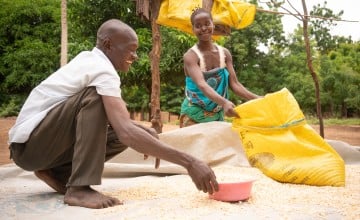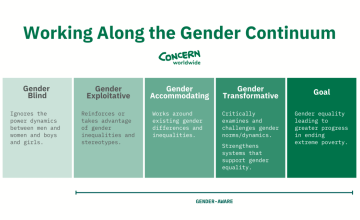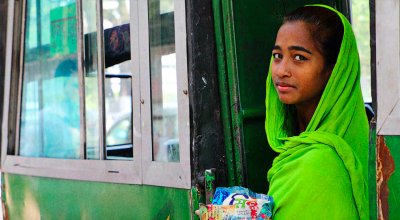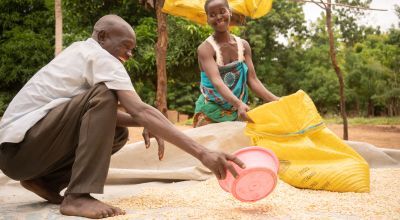
Read our 2023 annual report

Knowledge Hub
At Concern, gender equality is key to our work of ending poverty. What would that actually look like?
Gender equality is one of the top five sustainable development goals. We know that it’s a key issue to ending poverty, hunger, and other issues that plague our world today, and we know that millions of women and girls in every country around the world are fighting to assert and maintain their most basic human rights.
But what does gender equality actually look like? If we imagine a world with gender parity, we can come up with 13 points. These are just the tip of the iceberg, but they’re a starting point to envision equity.
1. Lower maternal and infant mortality rates
Gender bias in healthcare means that more than 800 women die every day due to preventable causes related to pregnancy and childbirth. In countries with high maternal mortality rates, infant mortality rates tend to follow suit.
Achieving greater gender equality in these countries — including challenging norms that restrict women from getting necessary healthcare, providing affordable and quality access to healthcare to the most vulnerable and remote communities, and prioritising nutrition for women who are pregnant, lactating, or of age to become pregnant — prevent millions of deaths.

2. Equal participation in the classroom
There are many barriers to a girl’s education: gender-based violence in the classroom, early marriage (more on that below), a lack of safe and adequate hygiene facilities, social norms that prioritise boys in the classroom, and a shortage of teachers with proper training. However, when girls and women are educated, economies shift and communities are transformed. A basic primary education sets girls on the right path to build the confidence, public speaking, negotiation skills, and awareness of their human rights — all of which are essential to gender equality.

3. High literacy and numeracy rates for boys and girls
Part of a quality education means that girls graduate from school able to read, write, and count. UNESCO reports that, despite a steady rise in literacy rates over the last 50 years, there are still 773 million illiterate adults around the world. Most of these people are women. This is a necessary gap to close for gender equality, both for future generations currently in school and adults who missed out on that same opportunity as children. But this doesn’t mean that men and boys should suffer — literacy and numeracy are building blocks of an essential education for people of all genders to understand what equity means and how they can work to achieve and maintain it.
4. Education on what matters outside of the classroom
We mentioned gender-based violence in the classroom above. School-related gender-based violence (SRGBV) is one of the forms of GBV, but it’s not the only one. Helping men and women as well as boys and girls to understand what constitutes GBV — a catchall term for everything from emotional abuse to rape to female genital mutilation (FGM) — is a key solution to GBV. This is one of the life skills that are essential for young children and adolescents to learn throughout their lives in order to achieve gender equality. Schools can play a large part in this type of education as well, with after-school clubs or other activities that include topics like gender, GBV, and sexual and reproductive health.

5. More women in the workplace
Many women who want to work are prevented from doing so — or are prevented from working for a fair wage and in a safe environment — by the patriarchal structures and dictates of their community. There are other gender issues around the workplace (more on those in a bit), but at the baseline level we first have to ensure that every woman who wishes to enter the workforce is able to do so in a safe and dignified working environment.
6. Women-owned businesses and land
In many countries where agriculture is the predominant industry, women farm the land but aren’t able to own it. Land passes between fathers, husbands, and sons, leaving women at an economic and financial disadvantage. Changing this will be a major step forward to building gender equality, especially within the workforce.

7. Financial empowerment and independence
It’s only in the last 50 years that women in even countries like Ireland and the United States were able to open a credit card in their own name. In many countries, financial independence still runs along gendered lines. Likewise, the gender pay gap is still an issue in every country in the world.
To support more active and equitable participation of women in the economy and land ownership, we will also need to address the lack of financial opportunities currently available to women in dozens of countries. Concern-led like Village Savings and Loans and Women’s Support Groups work to build financial literacy and equity within communities.

8. Waiting to get married
One of the most common threats to education is child marriage. The terms early or forced marriage are a bit more descriptive as it’s clear that marriage for girls (some as young as 15) is not by choice. Often, they’re married to much older men who can provide for them in cases where their own families cannot. This not only opens girls up to losing out on their education, but also exposes them to higher risks of sexual abuse and domestic violence. UNICEF estimates that approximately 650 million girls and women alive today were married before their 18th birthday.
9. Partners who are actually partners
Even if women wait to get married, they are more likely to spend more time at home focusing on the unpaid domestic labour — especially with children. Programmes at Concern like Umodzi in Malawi teach the importance of husbands and wives supporting each other. That support includes household chores and splitting childcare duties, but also means emotionally supporting one another as a team. (“Umodzi” means “united” in the Chichewa language, and the full name of the program is “Mutu Umodzi Susenza Denga” — “One Head Cannot Hold up the Roof.”)

10. More women in leadership
One of the biggest issues around gender equality in the workplace is a lack of women in leadership. A recent study conducted by McKinsey reveals a “broken rung” on the career ladder that is nowhere close to being fixed. For every 100 men promoted into leadership roles, only 87 women reach the same promotion — and only 82 women of colour.
This problem persists in other forms of leadership: Globally, women make up less than 25% of parliamentary bodies. We’ll see gender equality when there’s a greater balance in these leadership roles.
11. Media and community support for gender equality
Support beyond homes, schools, and workplaces is required for true, sustainable gender equality. This includes how local, national, and international media reinforce the importance of gender equality, as well as how key messages around equity are supported by the community — including religious leaders, elected representatives, and other figures of influence. Gender equality isn’t one-and-done, it requires constant support and maintenance.

12. Laws that support gender equality
On average, women have just 75% of the same rights as men. In order to sustain gender equality, it will need to be backed by laws that prohibit discrimination in the workplace on the basis of gender and criminalise domestic violence, sexual harassment, and marital rape.
13. Policies informed by gender equality
Other policies benefit from the involvement of women and girls with a focus on gender equity. This looks like women participating in peace processes and having a seat at other decision-making tables, workplaces and schools accommodating maternity leaves, lactating mothers, and menstrual health, abolishing the “pink tax,” and addressing period poverty. Involving women in the shaping of a society at all levels will help to ensure that these issues are accounted for and that gender equality can continue to flourish.
Gender equality: Concern’s response
Gender equality is one of the main pillars of Concern’s work and its importance cannot be understated. All of Concern’s programming, from health and nutrition to emergency response, happens through a gender transformative lens.

This means that we don’t simply work around existing gender differences or inequalities. Instead, we critically examine and challenge gender norms and dynamics in order to build equity and make greater, more sustainable progress towards ending extreme poverty. Where it makes sense, we also build and strengthen systems to support that level of equality.





